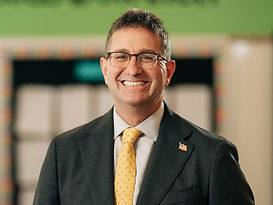GUEST COLUMN.
WHAT CAN BE DONE TO FIX TANF?
By Matt Lyons, Senior Director of Policy and Practice, American Public Human Services Association and Rebekah Sides, Policy Associate for Social and Economic Mobility, American Public Human Services Association

Sir Isaac Newton’s first law of motion tells us an object at rest will remain so unless compelled to change by the action of an external force. For the largest cash benefit and employment program in the United States—Temporary Assistance for Needy Families (TANF) —that push is finally coming.
TANF was established in 1996, replacing the previous Aid to Families with Dependent Children (AFDC) program as part of a bipartisan national welfare reform package. One significant element in the switch: The nation’s cash benefits were changed from an entitlement to a block grant. In lieu of a uniform, nationwide program available to all who are income-eligible—as is done for health care (Medicaid) or food (SNAP) —TANF’s block grant status means that each state receives a fixed grant amount from the federal government and a high degree of flexibility in how they use funding to support families experiencing poverty in alignment with four core purposes of TANF established by Congress.
With limited funding available to address big, structural issues impacting poverty in America, the flexibility in TANF allows states latitude to deploy resources in ways that can best serve their communities. Today, TANF is used to provide a wide range of critical services, including cash benefits to parents pursuing work, employment and training services, childcare, and short-term crisis assistance. When these resources are harnessed strategically to build the foundations of well-being that everyone needs to thrive, TANF can help to eliminate structural barriers to opportunity.
These are all estimable goals, yet major cracks in the original design of TANF more than twenty-five years ago have steadily undermined the ability of states to realize the impact aspired to for the program.
One of the core underlying problems was baked into the initial design of TANF, when states were required to comply with what is known as the Work Participation Rate (WPR). The WPR calculates what share of families receiving TANF cash assistance within a given state are enrolled in an eligible work activity for a set number of hours. If an insufficient share of TANF recipients meet the requirement, the state fails its WPR target and faces significant financial penalties.
Unfortunately, the rules determining whether a household is compliant with this work requirement show little regard for individuals’ circumstances, asking participants to conform to a rigid set of work activities, for a rigid number of hours, for a rigid period of time. Rather than meet families where they are, through individualized services tailored to their needs, participants are subject to a set of preordained rules or risk losing their benefits. Therein lies the paradox: this highly flexible funding source remains severely inflexible for its primary intended recipients.
The WPR is paired with an incentive structure that encourages states to shrink their caseloads, and as a result, it should be no surprise that the percentage of eligible families receiving TANF cash assistance has methodically declined from 68 percent in 1996 to 21 percent in 2020. Moreover, both overall federal funding levels for TANF—unchanged at $16.5 billion since 1996—and cash benefit levels for individual families have steadily depreciated over the past twenty-six years, leaving fewer resources available to fewer families and further diluting the program’s impact. Over the years, many states have faced criticism for unspent TANF funds and for using funding in ways perceived as disconnected from the program’s focus on family well-being and economic mobility for people experiencing poverty. These issues are symptoms surfacing from root causes in the underlying design of TANF.
Fortunately, a push for change is setting TANF on a new path and there is reason for hope.
Recent state efforts show us what TANF modernizations are already available and what could be possible with legislative reforms. Last year, the national network of state and county TANF administrators released a set of Core Principles for TANF Modernization, articulating a set of values for reforming the program and outlining a framework for Congressional action. Already, states are putting these principles into practice, implementing some of the largest increases in cash benefit levels in the history of the program in places such as Mississippi and Louisiana, and redesigning ways to engage participants in work based on measuring employment and family well-being outcomes and authentically listening to customers in places like Utah and California.
This year the federal government seems to have taken notice. In June, Congress quietly wrapped into the debt ceiling compromise package major reforms for TANF, including a nationwide set of outcome reporting measures and the establishment of a six-year pilot to test alternative performance benchmarks for states in lieu of the WPR. Shortly thereafter, the Administration introduced a sweeping set of proposed regulatory changes to TANF, impacting allowable spending and federal oversight in TANF with huge implications for state agencies and the customers they support. Discussions on a comprehensive, bipartisan Congressional reauthorization—which has not been passed since 2005—seem possible for the first time in many years.
Whether these federal policy changes and the surrounding energy for reform move TANF in the right direction remains to be seen. However, one thing is clear—our nation’s primary tool to meet basic needs and support economic mobility for families experiencing poverty is no longer an object at rest. The direction it moves next is incumbent on all of us.
The contents of this guest column reflect those of the author and not necessarily those of Barrett and Greene, Inc.



































































































